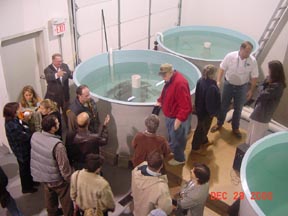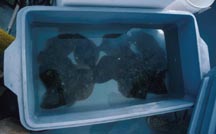
Selling
fish alive: Extra effort, but profitable
by Natalie Springuel, Maine Sea Grant
At a time when many fisheries throughout the eastern seaboard
are fraught with regulations and limits, more attention is being focused
on the potential for landing fish alive for sale to specialty markets.
Provided they can find a buyer and keep their catch healthy and alive
until the point of sale, fishermen who tap into this emerging value-added
specialty market can make a good living. The implications are potentially
far-reaching, both in terms of increasing fishermen's earnings and promoting
sustainable fisheries.
 |
| An open house at the Cape Live Seafood live fish holding facility in Harwich, MA.CCCHFA photo |
"Fishermen involved in the live fish market can catch less, make more money, and feel good about the resource," said John Pappalardo of the Cape Cod Commercial Hook Fishermen's Association (CCCHFA). CCCHFA and The Resources Inc. (TRI), an Orleans, MA-based nonprofit group, have undertaken a grant-funded project to develop systems for landing, holding, and marketing commercially caught live fish. CCCHFA and TRI created Cape Live Seafood to carry out the project.
Throughout the Mid-Atlantic and Northeast, the few fishermen involved in trying this option are finding that buyers pay significantly more for live fish than for fish on ice.
Live summer flounder can be worth as much as $8 a pound, according to Dave Russell from Aquabio Products Sciences LLC (APS), a research and development company in Portland, ME that has bought live flounder for one of its ongoing projects.
"Summer flounder fills a demand from the sushimi market," Russell said. The sushimi market wants fish in the 2-3 pound range, and smaller fish are worth less. Other flounder species that are landed live sell for at least $3 per pound, though that price can reach $5 a pound depending on the steadiness of supply, he said.
On Cape Cod, the live cod market brings about 20% to 25% more than dead fish. In Maryland, fisherman Bob Evans uses an aerated tank on his boat, to land and hold catfish. When the season is good, he can fill a tractor trailer a week.
"I'd much rather handle them live," Evans said. They don't lose weight." More weight of course, translates into more money for a live catch. It is no wonder more and more fishermen are interested in retrofitting their boats and getting involved in this potentially lucrative fishery.
Cautions
There are a few potential problems, however.
"Marine flatfish can develop the bends within 15 minutes and die immediately or up to a half a day later, depending on the severity. Just like scuba divers moving too quickly between different water levels, live fish are sensitive to temperature and water pressure changes," cautioned Dave Russell.
In places such as Lubec, ME, and Grand Manan, New Brunswick, Canada, where the temperature differential is small throughout the water column, Russell and others have found that the bends do not occur as readily. It is when there is a stratified column and substantial temperature differences, such as in the summertime in areas of low tidal mixing, that problems emerge.
The market, however, wants live fish year-round, so keeping fish alive and healthy, regardless of the season, is key. Care must be taken at each step to ensure fish are neither damaged physically nor visually marred. The trick lies in stabilizing the environmental changes that fish cannot withstand.
Fish capture
It starts right at the capture phase. To ensure survival, capture techniques
should minimize stress and trauma on the fish. Chris Bartlett, a marine
extension associate with Maine Sea Grant who has been working with fishing
boats in Downeast Maine to land live fish, explained that fishing gear
such as handlines, longlines, and a variety of traps can more effectively
prevent mortality than other capture methods.
 |
| Live cod that were caught by handlines are held in a tote supplied with seawater from a washdown hose. Photo by Chris Bartlett, Maine Sea Grant. |
When using hooks, the size, type, and placement of the hook affects the fish. Emphasis should be placed on hooking the fish in the mouth to avoid unnecessary injury.
"For example," Bartlett said, "circle hooks were chosen for a recent live halibut capture program because studies had shown those hooks caught fish in the lower jaw 87% of the time. Traditional baited J hooks are much more likely to be swallowed by the halibut or cause other injuries such as piercing the fish's eye."
Bartlett also added that care should be taken when hauling fish with swim bladders, such as cod, and other bony fish. The air trapped inside the bladder expands as the pressure decreases when the fish is hauled up.
"It must be relieved in order for the fish to survive," he said, "which can be done by using a needle to puncture the bladder and release the air."
Onboard live tanks
Once on deck, handling must also be extremely careful and special vessel
outfitting can be essential for year-round success.
Cape Live Seafood has been involved with the design and building of onboard tanks for use on selected hook fishing boats so they can bring their catch in alive. "It has taken some retrofitting, with a cost in the range of $3,000 to $4,000 a boat," Pappalardo said.
Floating tanks should be placed where they can be easily accessed to reduce excessive handling of fish. The live tanks need to include a plumbing system that can effectively recirculate water. A simple washdown hose can work in the cold weather months when the water temperature is low enough.
For warmer seasons, though, the project vessels refrigerate seawater for holding fish. "We are trying to work into the summer with titanium chillers," Pappalardo said. A chiller has a heat exchanger that draws the heat out of the water and keeps it at 42° to 45°. The system works off the engine and includes the chillers, a compressor, and a pump.
While water quality is usually not an issue with onboard tanks, fishermen have to be mindful of density."The boat holding tank densities should not exceed 1-1/2 pounds of fish per gallon of water. The fish can be transported from the boat to the holding facility by truck at the same densities," said Roy Castle, president of Castle's Aquaculture and Seafood Consulting Inc. and former director of the Aquaculture/Seafood Marketing Program for the Maryland Department of Agriculture.
Shoreside
Dave Russell, who raised tilapia in California for the live fish market
before joining APS, recommended that the first question fishermen should
ask before venturing into this business is: "Who is the buyer?"
He said that the current climate is good for fishermen wanting to sell live fish because "demand for live marine fish is still greater than supply." The Asian market, in particular, seeks a wide variety of species, including summer flounder, American eel, and black sea bass, for sushi and steamed fish.
Roy Castle added, "Fishermen need to diversify to meet these market demands. Offering 10 different species is far better than just one."
For fishermen, there are a few stumbling blocks to securing relationships with these markets, not least of which is the language barrier and cultural differences in dealing with Asian wholesalers. More recently, the larger eastern cities also have growing markets for sushi bars and gourmet restaurants.
But, Castle recommended, "It is often easier for most fishermen to work with a wholesaler or broker than to sell live fish directly to a retail market."
Skip Kemp, the North Carolina Sea Grant Seafood Marketing Specialist, said that buyers often bring their trucks directly to the dock so the trip needs to be worth it. "Eight hundred to 1,000 pounds is worth it," Kemp said.
Some fishermen in North Carolina have developed holding tanks on shore to safely keep fish alive until they can catch enough fish for a buyer to send a truck.
In November 2000, Cape Live Seafood opened a HACCP-certified facility in the town of Harwich, MA to hold live fish landed by the project's vessels in aerated tanks until buyers send trucks to pick them up.
When holding live fish, fishermen need to be aware of water quality considerations such as temperature, salinity, dissolved oxygen, and the fish density in a tank a particular species can withstand.
Although the handling of live fish requires special care for a fragile product and a discerning market, most would agree the timing is good for fishermen to explore the emerging options in the live fishery. For more information on handling live fish, contact your local Sea Grant extension program by going to www.nsgo.seagrant.org/